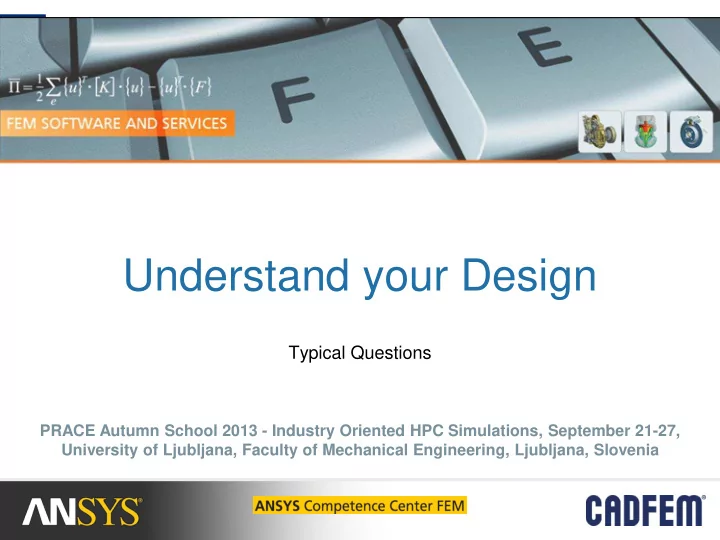

Understand your Design Typical Questions PRACE Autumn School 2013 - Industry Oriented HPC Simulations, September 21-27, University of Ljubljana, Faculty of Mechanical Engineering, Ljubljana, Slovenia
Content Typical Questions How to evaluate 1000 designs? Accuracy and numerical noise Robust parameter settings Which settings are the best for my design improvement? - 1 -
How to evaluate 1000 designs? Context senstive overview of all results. - 2 -
How to evaluate 1000 designs? The correlation matrix Red: Positive correlation Blue: Negative correlation Grey: No significant correlation. Check: Correlations not only bet- ween input and output but also between the different results! 3 - 3 -
How to evaluate 1000 designs? - Three input parameters show influence on the results. - Four parameters show no influence. 4 - 4 -
How to evaluate 1000 designs? MASS DEFORMATION STRESS Deformation and Stress: positive correlated Mass: negative correlation to stress and deformation Important for future design improvement. 5 - 5 -
How to evaluate 1000 designs? Get the overview of all correlations using the extended correlation matrix! - 6 -
How to evaluate 1000 designs? Parallel Coordinates Plot: - Good for a quick exploration of input/output trends - Check whether desired design improvement goals can be reached. - 7 -
The optiSLang Meta-model of Optimal Prognosis (MOP) Characterize the system behavior by a mathematical description Determination of the best approximation model The response surface visualizes the behavior model Filter out the unimportant parameters Asses the forecast quality of the model: The Coefficient of Prognosis (CoP) Estimate occuring numerical noise Check concerning nonlinear correlation Explore improvement possibilites - 8 -
The Coefficient of Prognosis (CoP) Estimation of the forecast quality of the approximation model Explain the model behavior with a reduced parameter set Handle nonlinearities Determine coupled correlation – some parameters boost or efface each other A low CoP indicates occuring numerical noise - 9 -
Accuracy and numerical noise Check accuracy using the Coefficient of Prognosis A CoP of larger than ~80% is a good start value for further design improvement What if CoP is < 60..70% ? Check variation space (to big / small)? Forget some very important parameters? Too much numerical noise in my model? Too less samples? Difficulties in result extraction? - 10 -
Reviewing the results Histograms: Relative distribution of result values Determination of critical stages Check for possible design improvement - 11 -
Robust parameter settings What are robust parameter setting? The solution always converges The geometry can always be generated The mesh can always be created Can we determine robust parameter settings in advance? Do we even need them? - 12 -
Determining robust parameter settings optiSLang enables you to visualize failed designs to show the expected position in the variation space! - 13 -
BUT - Do we need always converging and regeneratable models? optiSLang can deal with failed designs! Do not limit your variation space! Rather accept failed designs than loosing information! - 14 -
Restart option What is if your computer system crashes or you need it for other purpose? optiSLang can be interrupted and restarted at any time. - 15 -
Recommend
More recommend